Trustworthy Wireless Sensor Networks for Monitoring Humidity and Moisture Environments
Abstract
1. Introduction
2. Related Work
2.1. Agriculture and Industry Monitoring Environment
2.2. Trust Models
3. Materials and Methods
- -
- An algorithm for signing. This algorithm generates a digital signature for a given message and a private key;
- -
- An algorithm for verification of the digital signature. This algorithm verifies or denies whether a message is authentic based on the message, public key, and signature.
4. The Trust WSN Model for Humidity and Moisture Monitoring
4.1. Prerequisites for Establishing a Trusted WSN
4.1.1. The Requirements for PKI and TSA Selection for the Establishment of a Trusted WSN
4.1.2. The Entity Initialization
4.2. Generating Tokens for Establishing Trust
- Step 1. The original message is generated (sampling value of the sensor or the message sent by the access point (AP) or the message sent by the monitoring application, depending on which entity is being observed);
- Step 2. Calculating the hash value of the original message using the hash function (e.g., SHA-1);
- Step 3. The hash value of the original message is encrypted with the RSA algorithm and the private key of the entity (e.g., 1024 bits). A digital signature has now been created;
- Step 4. A new message format (authentication token) is created: original message, digital signature, entity certificate;
- Step 5. The sensor generates a timestamp request with the hash value obtained during the formation of the authentication token;
- Step 6. The sensor sends a TSA timestamp request;
- Step 7. Receives a response from the TSA (time token) in the following format: digitally signed timestamp token, time generated by the TSA, and digital TSA certificate;
- Step 8. Creating the authentication token and time token in the following data format: data, digital signature, sensor certificate, digitally signed timestamp token, time generated by TSA, and digital TSA certificate.
4.3. The Token Verification for Establishing Trust
- Step 1. Deconcatenation of the authentication token to the original message, digital signature, and sender entity certificate;
- Step 2. Checking the validity of the sender’s certificate;
- Step 3. The same hash function (e.g., SHA-1) calculates the hash value of the original message;
- Step 4. The digital signature is decrypted by the RSA algorithm and the sender’s public key (from a digital certificate, e.g., 1024 bits);
- Step 5. The obtained values are compared. The digital signature is valid if the values are the same. This means that the message was sent by the entity currently being represented.
- Step 6. Deconcatenation of the time token to the TSA certificate, original message, time and timestamp;
- Step 7. Validation of the TSA certificate as described in below. The certificate chain is the TSA certificate and then the root CA certificate. The root CA signs the TSA certificate.
- Step 8. The same hash function (e.g., SHA-1) calculates the hash value of the source data (done during digital signature verification);
- Step 9. Concatenation of the calculated hash value and time;
- Step 10. The hash function calculates a hash value from the data hash value and time;
- Step 11. The decryption of a trusted timestamp with a public key from a TSA digital certificate;
- Step 12. Comparison of the obtained hash value and decryption content.
- Verification of trust in the certificate authority: The certificate chain starts from a root CA certificate (highest trust point) via an intermediate CA certificate (this certificate is digitally signed with a CA root private key) and an entity certificate (the certificate is signed with an Intermediate CA private key). Verification is performed by verifying the digital signature of the root CA certificate and the Intermediate CA certificate using the CA root public key, while verification of the entity certificate digital signature is performed by using the Intermediate CA public key. If this can be done successfully, then there is trust in the certificate chain, i.e., that the certificate was issued to the entity by a trustworthy CA.
- The certificate status is checked based on whether the certificate has been revoked or suspended. Checking is performed for all certificates in the certificate chain. This is done by searching the certification revocation list (assuming that the lists (root CA CRL and intermediate CA CRL) are located at the entity).
- Certificate validation involves verifying the expiration date for all certificates in the certificate trust chain.
5. Proposed Model Evaluation
5.1. Average Energy Consumption
5.2. Average Packet Delay
5.3. Free Timestamping Authority Evaluation
5.3.1. Simulation of TSA Efficiency in Monitoring Humidity and Moisture Environment with One Application
5.3.2. Simulation of TSA Efficiency for Monitoring Humidity and Moisture Environment with Two Applications
5.3.3. Simulation of TSA Efficiency for Humidity and Moisture Environment with Three Monitoring Applications
5.4. Security Evaluation
- The attacker cannot jeopardize the established trust by changing the content of the entity digital certificate because checking the trust chain on the recipient side would determine that the certificate content of the sender sensor has changed. The transaction would be rejected as untrustworthy because it comes from an untrustworthy source.
- Falsification of a digital certificate means that there is a digital certificate with the same content but signed by a fake certification authority. It would be established in the process of the certificate chain verifying that the certificate was not issued by a certification authority that is trusted. As a consequence of the above, a sensor that has such a certificate would not be trusted.
- Changing or falsification of the trust chain cannot jeopardize trust because checking the trust chain would reveal that it has not been issued by a certification authority that the entity trusts.
- The digital signature changes cannot affect trust because the applied asymmetric cryptography in the digital signature verification process would indicate that there has been a change in the digital signature. This indicates that the authentication token or certificates in the trust chain are not signed by the party that has the private key corresponding to the public key in the certificate, or the digital signature has been maliciously altered to avoid establishing trust.
6. Conclusions
Author Contributions
Funding
Institutional Review Board Statement
Informed Consent Statement
Data Availability Statement
Acknowledgments
Conflicts of Interest
References
- Shokat, A.; Singh, R.P.; Javaid, M.; Haleem, A.; Pasricha, H.; Suman, R.; Karloopia, J. A Review of the Role of Smart Wireless Medical Sensor Network in COVID-19. J. Ind. Integr. Manag. 2020, 05, 413–425. [Google Scholar] [CrossRef]
- Shalabi, M. COVID-19 Symptoms Monitoring Mechanism using Internet of Things and Wireless Sensor Networks. IJCSNS 2020, 20, 16–20. [Google Scholar]
- Sarang, S.; Drieberg, M.; Awang, A.; Ahmad, R. A QoS MAC protocol for prioritized data in energy harvesting wireless sensor networks. Comput. Netw. 2018, 144, 141–153. [Google Scholar] [CrossRef]
- Ruan, T.; Chew, Z.J.; Zhu, M. Energy-aware approaches for energy harvesting powered wireless sensor nodes. IEEE Sens. J. 2017, 17, 2165–2173. [Google Scholar] [CrossRef]
- Gaikwad, S.V.; Galande, S.G. Measurement of NPK, Temperature, Moisture, Humidity using WSN. Int. J. Eng. Res. Appl. 2015, 5, 84–89. [Google Scholar]
- Jawad, H.M.; Nordin, R.; Gharghan, S.K.; Jawad, A.M.; Ismail, M. Energy-efficient wireless sensor networks for precision agriculture: A review. Sensors 2017, 17, 1781. [Google Scholar] [CrossRef]
- Ege, I.; Gökhan-Sensoy, M.; Kalender, O.; Nazlıbilek, S.; Citak, H. A new wireless asynchronous data communications module for industrial applications. Measurement 2013, 46, 2672–2681. [Google Scholar] [CrossRef]
- Yuan, Y.; Xu, Q.; Guan, X.; Liu, Z. Industrial high-speed wireless synchronous data acquisition system with real-time data compression. Measurement 2013, 46, 3482–3487. [Google Scholar] [CrossRef]
- Arthi, K.; Vijayalakshmi, A.; Vanaja-Ranjan, P. Critical event based multichannel process control monitoring using WSN for industrial applications. Int. Conf. Des. Manuf. 2013, 64, 142–148. [Google Scholar] [CrossRef]
- Aponte-Luis, J.; Gómez-Galán, J.A.; Gómez-Bravo, F.; Sánchez-Raya, M.; Alcina-Espigado, J.; Teixido-Rovira, P.M. An Efficient Wireless Sensor Network for Industrial Monitoring and Control. Sensors 2018, 18, 182. [Google Scholar] [CrossRef]
- Zhu, Y.; Song, J.; Dong, F. Applications of wireless sensor network in the agriculture environment monitoring. Procedia Eng. 2011, 16, 608–614. [Google Scholar] [CrossRef]
- Satyanarayana, G.V.; Mazaruddin, S.D. Wireless Sensor Based Remote Monitoring System for Agriculture Using ZigBee and GPS. In Proceedings of the Conference on Advances in Communication and Control Systems, Mumbai, India, 18–19 January 2013; pp. 110–114. [Google Scholar]
- Muangprathub, J.; Boonnam, N.; Kajornkasirat, S.; Lekbangpong, N.; Wanichsombat, A.; Nillaor, P. IoT and agriculture data analysis for smart farm. Comput. Electron. Agric. 2019, 156, 467–474. [Google Scholar] [CrossRef]
- Kamelia, L.; Ramdhani, M.A.; Faroqi, A.; Rifadiapriyana, V. Implementation of Automation System for Humidity Monitoring and Irrigation System. IOP Conf. Ser. Mater. Sci. Eng. 2018, 288, 012092. [Google Scholar] [CrossRef]
- Lakshmisudha, K.; Hegde, S.; Kale, N.; Iyer, S. Smart Precision based Agriculture using Sensors. Int. J. Comput. Appl. 2016, 146, 36–38. [Google Scholar] [CrossRef]
- Imam, S.A.; Choudhary, A.; Sachan, V.K. Design issues for wireless sensor networks and smart humidity sensors for precision agriculture: A review. In Proceedings of the 2015 International Conference on Soft Computing Techniques and Implementations (ICSCTI), Faridabad, India, 8–10 October 2015; pp. 181–187. [Google Scholar] [CrossRef]
- Pethe, R.M.; Asutkar, S.M. Wireless Sensor Network for Industrial Applications. Int. J. Future Revolut. Comput. Sci. Commun. Eng. 2015, 1, 22–25. [Google Scholar]
- Barón Suárez, J.C.; Barón Suárez, M.J. Application of SHT71 sensor to measure humidity and temperature with a WSN. In Proceedings of the IEEE 9th IberoAmerican Congress on Sensors, Bogota, Colombia, 15 October 2014; pp. 1–7. [Google Scholar] [CrossRef]
- Nooriman, W.M.; Abdullah, A.H.; Rahim, N.A.; Kamarudin, K. Development of wireless sensor network for Harumanis Mango orchard’s temperature, humidity and soil moisture monitoring. In Proceedings of the IEEE Symposium on Computer Applications & Industrial Electronics (ISCAIE), Penang, Malaysia, 28 April 2018; pp. 263–268. [Google Scholar] [CrossRef]
- Rani, V.U.; Sundaram, K. Review of Trust Models in Wireless Sensor Networks. World Acad. Sci. Eng. Technol. 2014, 8, 371–377. [Google Scholar]
- Chen, Z.; Tian, L.; Lin, C. Trust Model of Wireless Sensor Networks and Its Application in Data Fusion. Sensors 2017, 17, 703. [Google Scholar] [CrossRef] [PubMed]
- Jiang, J.; Han, G.; Wang, F.; Shu, L.; Guizani, M. An Efficient Distributed Trust Model for Wireless Sensor Networks. IEEE Trans. Parallel Distrib. Syst. 2015, 26, 1228–1237. [Google Scholar] [CrossRef]
- Govindan, K.; Mohapatra, P. Trust Computations and Trust Dynamics in Mobile Adhoc Networks: A Survey. IEEE Commun. Surv. Tutor. 2012, 14, 279–298. [Google Scholar] [CrossRef]
- Wu, X.; Huang, J.; Ling, J.; Shu, L. BLTM: Beta and LQI Based Trust Model for Wireless Sensor Networks. IEEE Access 2019, 7, 43679–43690. [Google Scholar] [CrossRef]
- Chen, H.; Wu, H.; Zhou, X.; Gao, C. Agent-based Trust Model in Wireless Sensor Networks. In Proceedings of the Eighth ACIS International Conference on Software Engineering, Artificial Intelligence, Networking, and Parallel/Distributed Computing (SNPD 2007), Qingdao, China, 30 July–1 August 2007; pp. 119–124. [Google Scholar] [CrossRef]
- Rathore, H.; Badarla, V.; George, K.J. Sociopsychological trust model for Wireless Sensor Networks. J. Netw. Comput. Appl. 2016, 62, 75–87. [Google Scholar] [CrossRef]
- Lu, Z.; Liu, W.; Wang, Q.; Qu, G.; Liu, Z. A Privacy-Preserving Trust Model Based on Blockchain for VANETs. IEEE Access 2018, 6, 45655–45664. [Google Scholar] [CrossRef]
- She, W.; Liu, Q.; Tian, Z.; Chen, J.; Wang, B.; Liu, W. Blockchain Trust Model for Malicious Node Detection in Wireless Sensor Networks. IEEE Access 2019, 7, 38947–38956. [Google Scholar] [CrossRef]
- Ning, H.; Liu, H.; Yang, T.L. Cyberentity security in the Internet of Things. Computer 2013, 46, 46–53. [Google Scholar] [CrossRef]
- Vulić, I.; Prodanović, R.; Vukčević, G.; Sretenović, S. Trust Establishing Model in IoT using PKI and Timestamp. In ICIST 2018 Proceedings; Konjović, Z., Zdravković, M., Trajanović, M., Eds.; Eventiotic: Kopaonik, Serbia, 2018; Volume 2, pp. 333–338. [Google Scholar]
- Han, G.; Jiang, J.; Shu, L.; Niu, J.; Chao, H.-C. Management and applications of trust in Wireless Sensor Networks: A survey. J. Comput. Syst. Sci. 2014, 80, 602–617. [Google Scholar] [CrossRef]
- Prodanović, R.; Rančić, D.; Vulić, I.; Zorić, N.; Bogićević, D.; Ostojić, G.; Sarang, S.; Stankovski, S. Wireless Sensor Network in Agriculture: Model of Cyber Security. Sensors. 2020, 20, 6747. [Google Scholar] [CrossRef]
- Lacuesta, R.; Palacios-Navarro, G.; Cetina, C.; Peñalver, L.; Lloret, J. Internet of things: Where to be is to trust. J. Wirel. Commun. Netw. 2012, 203. [Google Scholar] [CrossRef]
- Schukat, M.; Cortijo, P. Public key infrastructures and digital certicates for the internet of things. In Proceedings of the 26th Irish Signals and Systems Conference (ISSC), Carlow, Ireland, 24–25 June 2015; pp. 1–5. [Google Scholar]
- Cooper, D.; Santesson, S.; Farrell, S.; Boeyen, S.; Housley, R.; Polk, W. Internet x.509 Public Key Infrastructure Certifcate and Certificate Revocation List (crl) Profile. RFC 5280, RFC Editor. May 2008. Available online: http://www:rfc-editor:org/rfc/rfc5280:txt (accessed on 25 February 2021).
- Buldas, A.; Lipmaa, H.; Schoenmakers, B. Optimally Efficient Accountable Time-Stamping. In Public Key Cryptography. PKC 2000. Lecture Notes in Computer Science; Imai, H., Zheng, Y., Eds.; Springer: Berlin/Heidelberg, Germany, 2000; Volume 1751. [Google Scholar] [CrossRef]
- Sarang, S.; Stojanović, G.M.; Stankovski, S.; Trpovski, Ž.; Drieberg, M. Energy-Efficient Asynchronous QoS MAC Protocol for Wireless Sensor Networks. Wirel. Commun. Mob. Comput. 2020, 2020, 8860371. [Google Scholar] [CrossRef]
- Radosavljević, N.; Babić, Đ. Overview of Security Threats, Prevention and Protection Mechanisms in Wireless Sensor Networks. J. Mechatron. Autom. Identif. Technol. 2020, 5, 1–6. [Google Scholar]
- Mu, W.; Shaoqi, G.; Stankovski, S.; Zhang, X.; Kanianska, R.; Feng, J. WebGIS-based suitability evaluation system for Chinese table grape production. Comput. Electron. Agric. 2019, 165, 104945. [Google Scholar] [CrossRef]
- Prodanović, R.; Vulić, I.; Tot, I. A survey of PKI architecture. In Proceedings of the 5th International Scientific Conference on Knowledge Based Sustainable Development—ERAZ 2019, Budapest, Hungary, 23 May 2019. [Google Scholar] [CrossRef]
- Prodanović, R.; Vulić, I. Classification as an Approach To Public Key Infrastructure Requirements Analysis. IET Softw. 2019, 13, 518–527. [Google Scholar] [CrossRef]
- Milinković, S.; Milojković, B.; Spasić, D.; Lazić, L. Evaluation of some time-stamping authority software. In Proceedings of the to be presented at the 6th International Conference on Methodologies, Technologies and Toolsenabling e-Government, Belgrade, Serbia, 3–5 July 2012. [Google Scholar]
- Prodanović, R.; Vulić, I. Failure Points in the PKI Architecture. Vojnoteh. Glas. Mil. Tech. Cour. 2017, 65, 771–784. [Google Scholar] [CrossRef][Green Version]
- Shirey, R. Internet Security Glossary, Version 2; RFC 4949. Available online: https://datatracker.ietf.org/doc/html/rfc4949 (accessed on 21 January 2021).
- Gulen, U.; Alkhodary, A.; Baktir, S. Implementing RSA for wireless sensor nodes. Sensors 2019, 19, 2864. [Google Scholar] [CrossRef] [PubMed]
- Boulis, A. Castalia: A Simulator for Wireless Sensor Networks and Body Area Networks; National ICT Australia: Sydney, Australia, 2011. [Google Scholar]
- Sarang, S.; Drieberg, M.; Awang, A. Multi-priority based QoS MAC protocol for wireless sensor networks. In Proceedings of the 2017 7th IEEE International Conference on System Engineering and Technology (ICSET), Shah Alam, Malaysia, 2–3 October 2017; pp. 54–58. [Google Scholar]
- Han, R.; Yang, W.; Wang, Y.; You, K. DCE: A distributed energy-efficient clustering protocol for wireless sensor network based on double-phase cluster-head election. Sensors 2017, 17, 998. [Google Scholar] [CrossRef] [PubMed]
- Ascertia TSA Crusher. Available online: https://www.ascertia.com/products/tsa-crusher/ (accessed on 11 February 2021).
- Wennerström, H. Meteorological Impact and Transmission Errors in Outdoor Wireless Sensor Networks. Ph.D. Thesis, Dept. Inf. Technol., Uppsala Univ., Uppsala, Sweden, 2013. [Google Scholar]
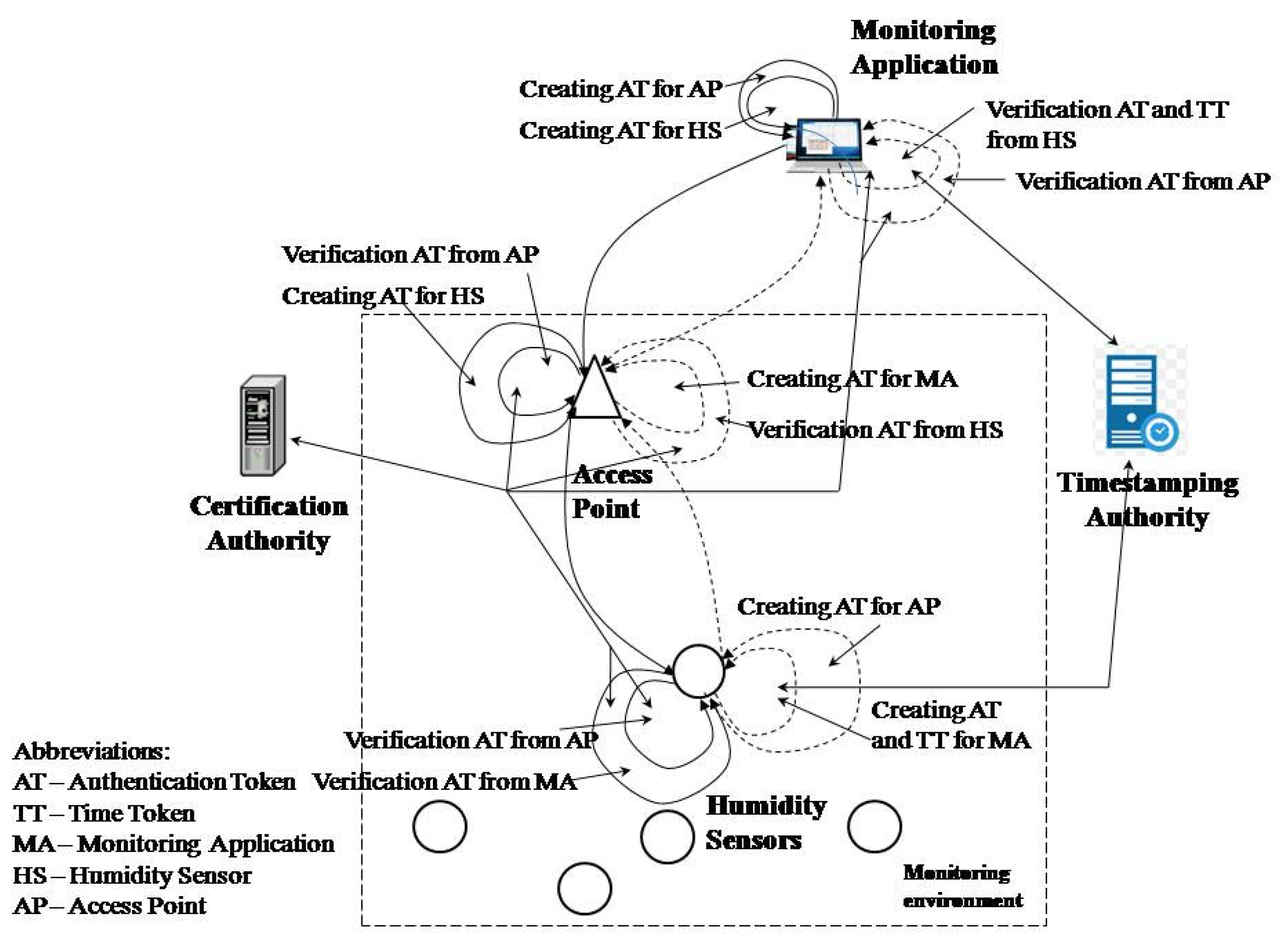

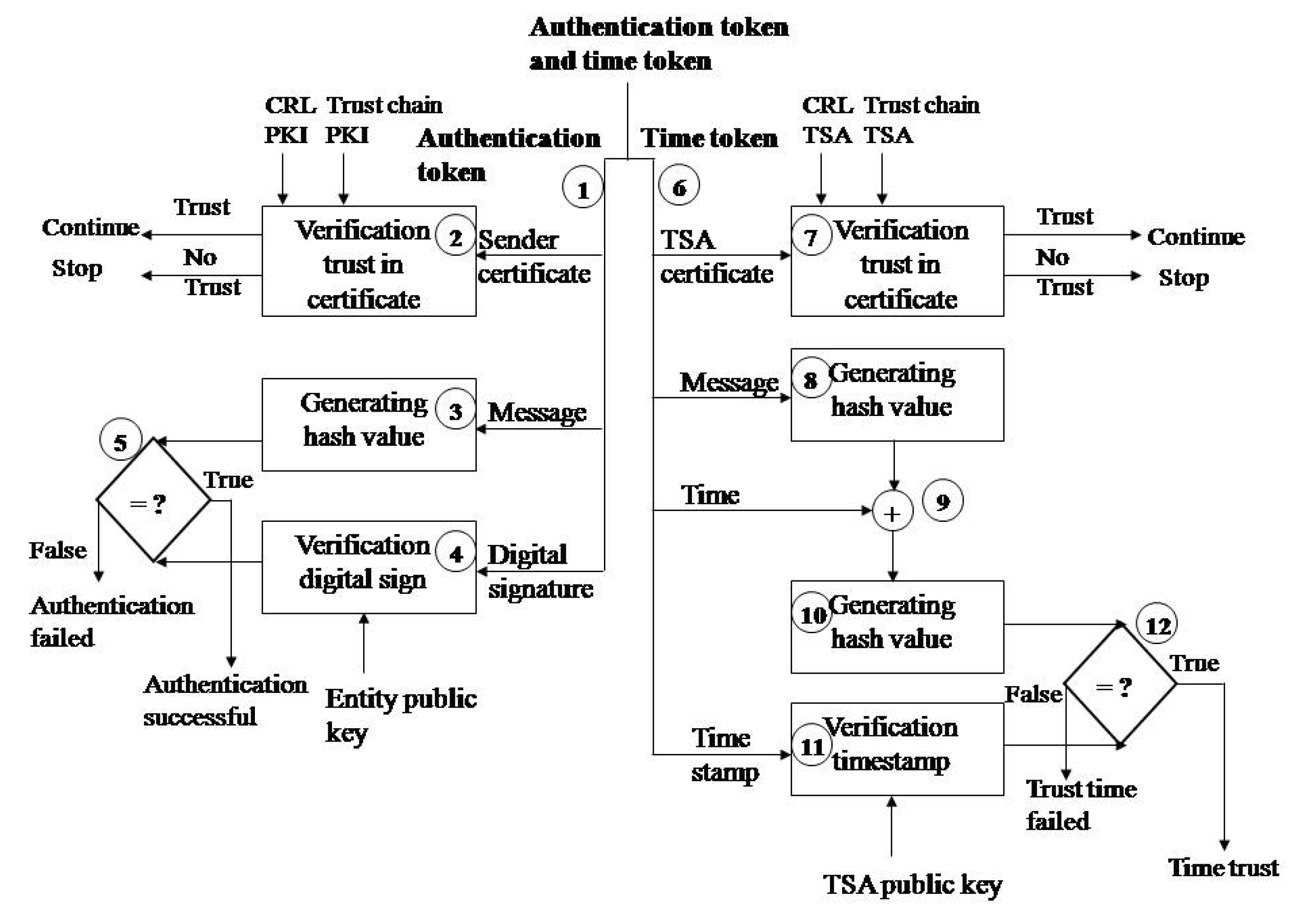
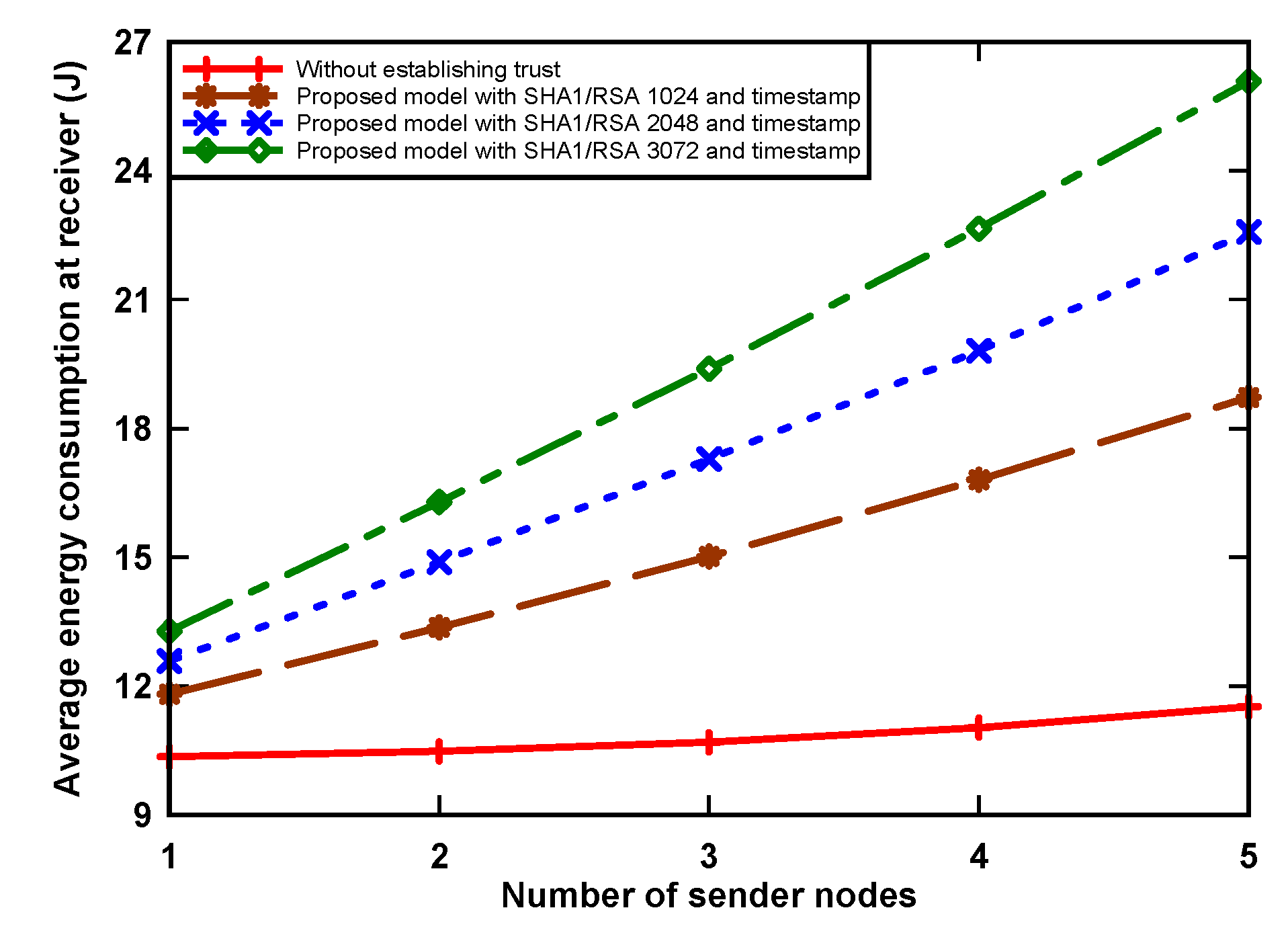
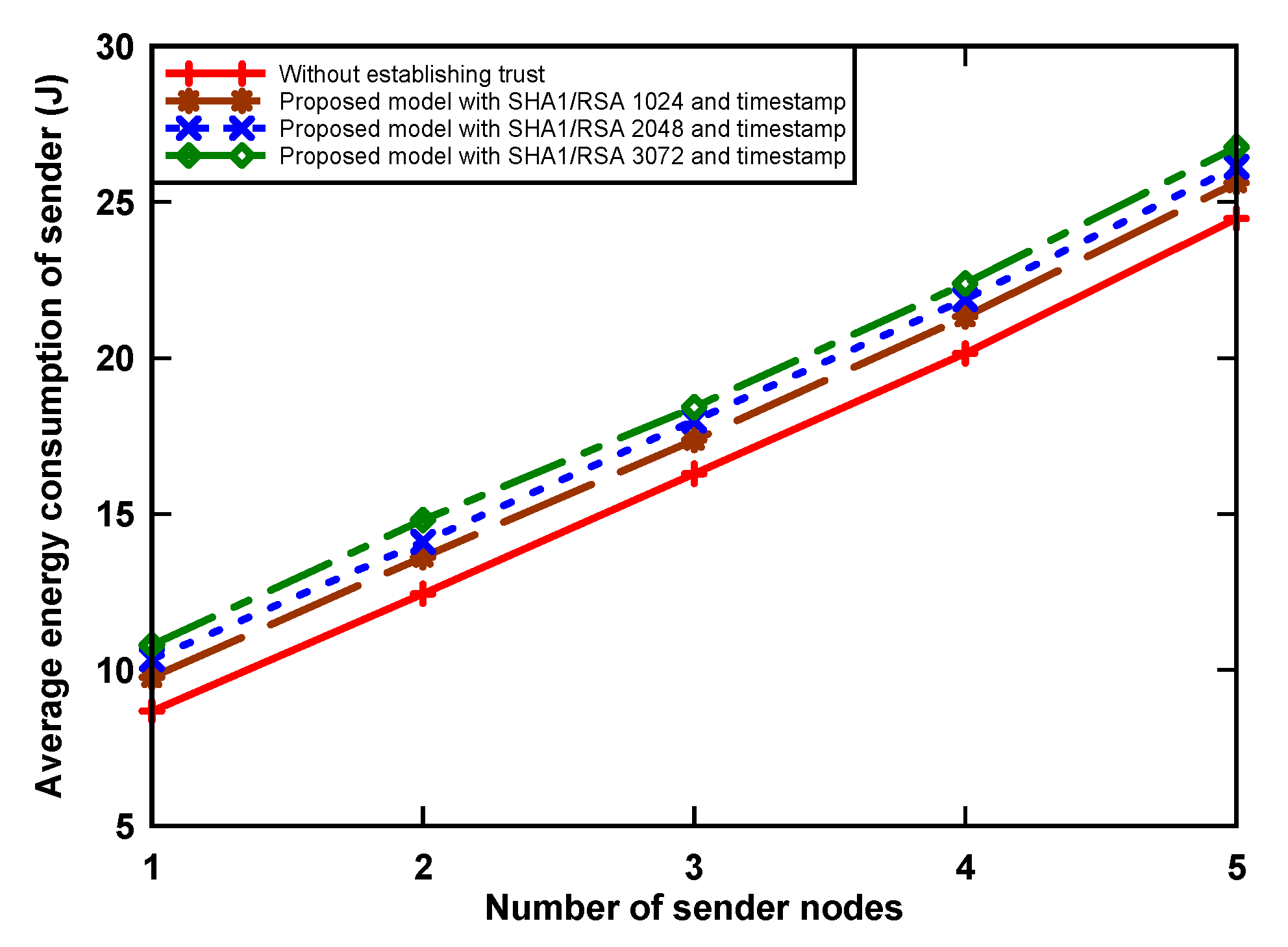
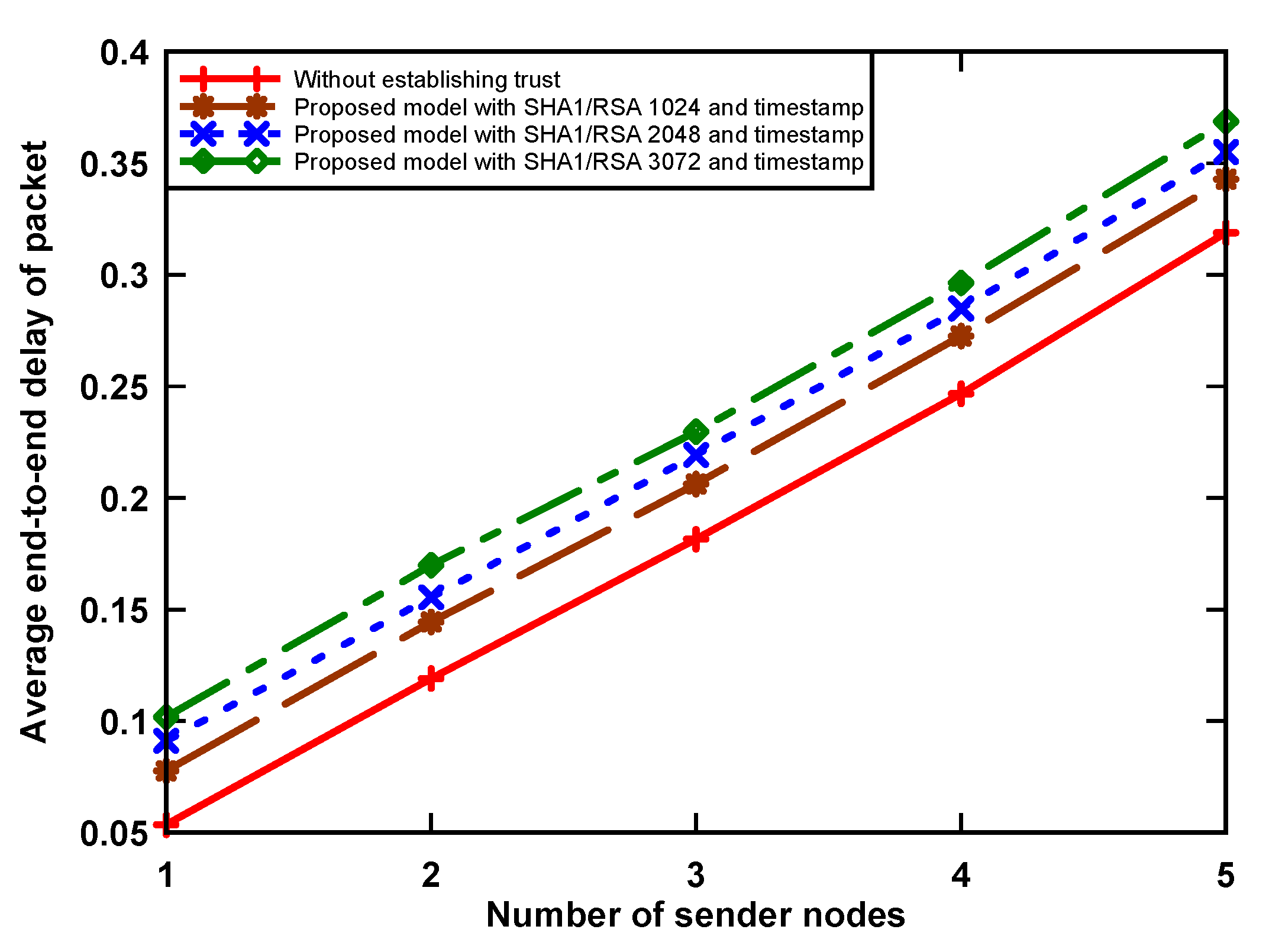
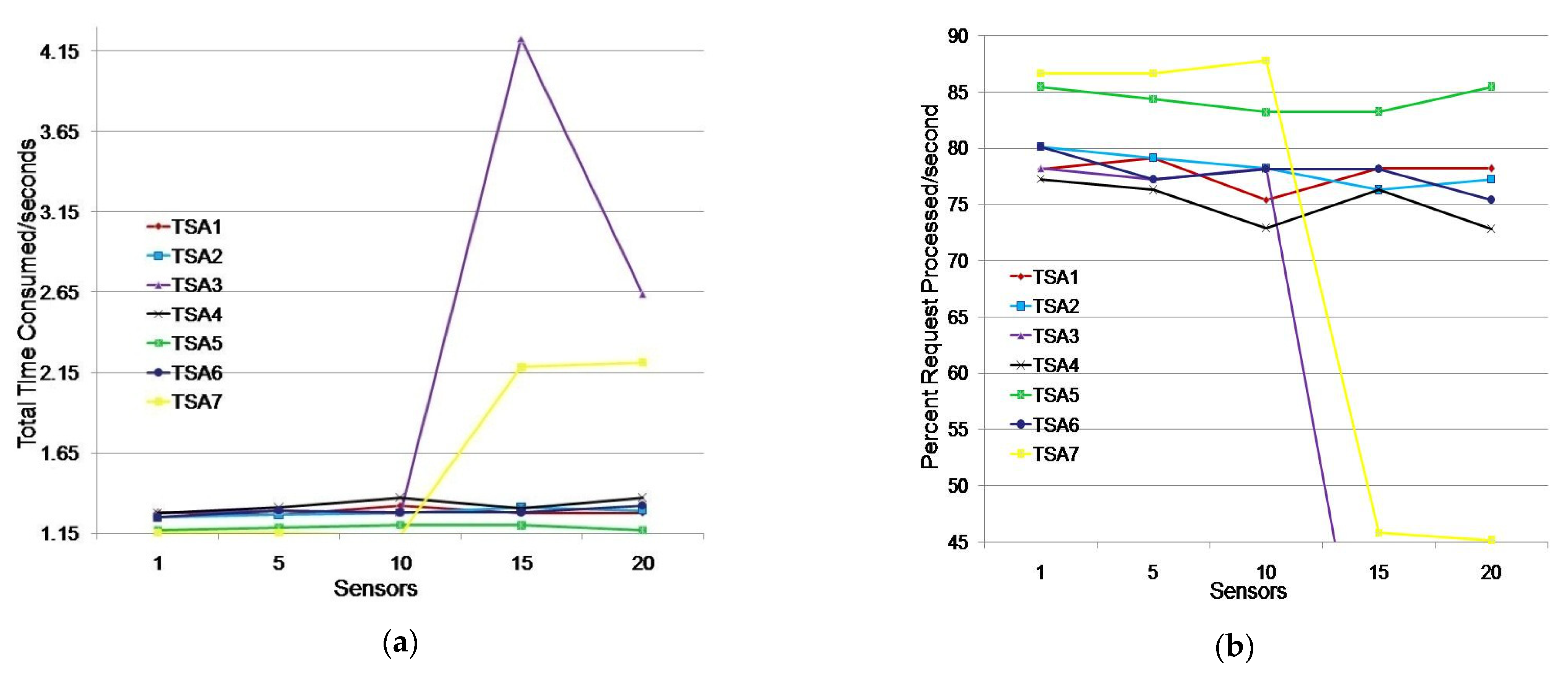
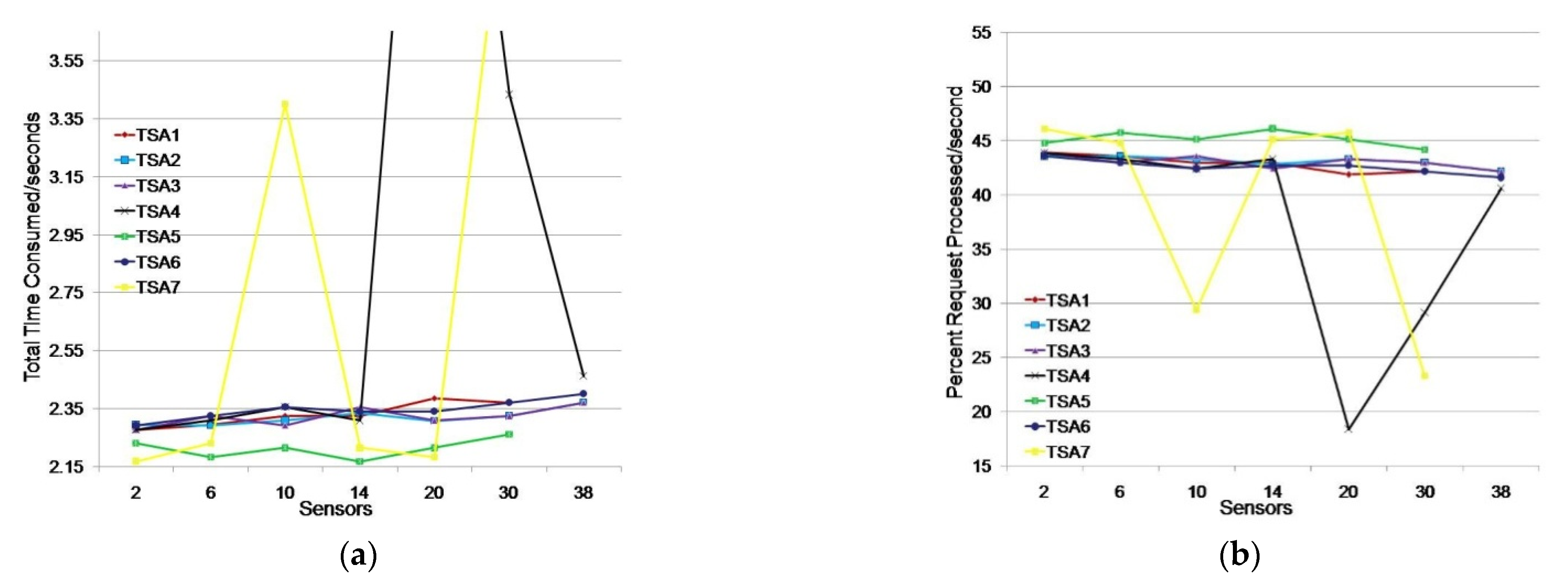

| Parameter | Value |
|---|---|
| Simulation time | 1000 s |
| Transmission power | 57.42 mW |
| Receiving power | 62.04 mW |
| Idle listening power | 62.04 mW |
| Sleeping power | 1.4 mW |
| Size of data packet | 32 bytes |
| Packet rate | 1 packet/s |
| Sender nodes | 1 to 5 |
| Listen interval | 60 ms |
| Duty cycle | 0.5 |
| Bandwidth | 250 kbps |
| Short TSA Name | TSA URL |
|---|---|
| TSA1 | http://zeitstempel.dfn.de (accessed on 3 March 2021) |
| TSA2 | http://timestamp.apple.com/ts01 (accessed on 3 March 2021) |
| TSA3 | http://time.certum.pl (accessed on 3 March 2021) |
| TSA4 | http://adobe-timestamp.geotrust.com/tsa (accessed on 3 March 2021) |
| TSA5 | http://tsa.swisssign.net (accessed on 3 March 2021) |
| TSA6 | http://timestamp.entrust.net/TSS/RFC3161sha2TS (accessed on 3 March 2021) |
| TSA7 | http://rfc3161timestamp.globalsign.com/advanced (accessed on 3 March 2021) |
| Sensors | Measured Values | TSA1 | TSA2 | TSA3 | TSA4 | TSA5 | TSA6 | TSA7 |
|---|---|---|---|---|---|---|---|---|
| 1 | TTC (s) | 1.280 | 1.248 | 1.279 | 1.295 | 1.170 | 1.248 | 1.154 |
| PRP (%) | 78.13 | 80.13 | 78.19 | 77.22 | 85.47 | 80.13 | 86.66 | |
| 5 | TTC (s) | 1.264 | 1.264 | 1.295 | 1.311 | 1.185 | 1.295 | 1.154 |
| PRP (%) | 79.11 | 79.11 | 77.22 | 76.28 | 84.39 | 77.22 | 86.66 | |
| 10 | TTC (s) | 1.326 | 1.279 | 1.279 | 1.372 | 1.202 | 1.280 | 1.139 |
| PRP (%) | 75.41 | 78.19 | 78.19 | 72.89 | 83.19 | 78.13 | 87.80 | |
| 15 | TTC (s) | 1.279 | 1.311 | 1.315 | 1.310 | 1.201 | 1.280 | 1.301 |
| PRP (%) | 78.19 | 76.28 | 76.05 | 76.34 | 83.26 | 78.13 | 76.86 | |
| 20 | TTC (s) | 1.279 | 1.295 | 1.306 | 1.373 | 1.170 | 1.326 | 1.366 |
| PRP (%) | 78.19 | 77.22 | 76.60 | 72.83 | 85.47 | 75.41 | 74.85 | |
| Average value | TTC (s) | 1.286 | 1.279 | 1.295 | 1.332 | 1.186 | 1.286 | 1.217 |
| PRP (%) | 77.81 | 78.19 | 77.24 | 75.11 | 84.36 | 77.80 | 82.56 |
| Sensors | Measured Values | TSA1 | TSA2 | TSA3 | TSA4 | TSA5 | TSA6 | TSA7 |
|---|---|---|---|---|---|---|---|---|
| 2 | TTC (s) | 2.277 | 2.294 | 2.277 | 2.278 | 2.231 | 2.293 | 2.169 |
| PRP (%) | 43.92 | 43.59 | 43.92 | 43.90 | 44.82 | 43.61 | 46.10 | |
| 6 | TTC (s) | 2.294 | 2.293 | 2.324 | 2.309 | 2.184 | 2.325 | 2.231 |
| PRP (%) | 43.59 | 43.61 | 43.03 | 43.31 | 45.79 | 43.01 | 44.82 | |
| 10 | TTC (s) | 2.325 | 2.309 | 2.293 | 2.356 | 2.215 | 2.356 | 3.401 |
| PRP (%) | 43.01 | 43.31 | 43.61 | 42.44 | 45.15 | 42.44 | 29.40 | |
| 14 | TTC (s) | 2.324 | 2.335 | 2.355 | 2.309 | 2.168 | 2.340 | 2.215 |
| PRP (%) | 43.03 | 42.83 | 42.46 | 43.31 | 46.13 | 42.74 | 45.15 | |
| 20 | TTC (s) | 2.387 | 2.308 | 2.309 | 5.429 | 2.215 | 2.340 | 2.184 |
| PRP (%) | 41.89 | 43.33 | 43.31 | 18.42 | 45.15 | 42.74 | 45.79 | |
| 30 | TTC (s) | 2.371 | 2.324 | 2.324 | 3.432 | 2.262 | 2.371 | 4.290 |
| PRP (%) | 42.18 | 43.03 | 43.03 | 29.14 | 44.21 | 42.18 | 23.31 | |
| 38 | TTC (s) | - | 2.371 | 2.372 | 2.462 | - | 2.402 | - |
| PRP (%) | - | 42.18 | 42.16 | 40.62 | - | 41.63 | - | |
| Average value | TTC (s) | 2.330 | 2.319 | 2.322 | 2.939 | 2.213 | 2.347 | 2.748 |
| PRP (%) | 42.94 | 43.12 | 43.07 | 37.31 | 45.21 | 42.62 | 39.10 |
| Sensors | Measured Values | TSA1 | TSA2 | TSA3 | TSA4 | TSA5 | TSA6 | TSA7 |
|---|---|---|---|---|---|---|---|---|
| 2 | TTC (s) | 3.307 | 3.307 | 3.323 | 3.232 | 3.167 | 3.338 | 3.214 |
| PRP (%) | 30.24 | 30.24 | 30.09 | 30.94 | 31.58 | 29.96 | 31.11 | |
| 6 | TTC (s) | 3.354 | 3.353 | 3.338 | 3.354 | 3.224 | 3.354 | 3.214 |
| PRP (%) | 29.82 | 29.82 | 29.96 | 29.82 | 31.02 | 29.82 | 31.11 | |
| 10 | TTC (s) | 3.339 | 3.322 | 3.354 | 3.354 | 3.229 | 3.338 | 3.229 |
| PRP (%) | 29.95 | 30.10 | 29.82 | 29.82 | 30.97 | 29.96 | 30.97 | |
| 14 | TTC (s) | 3.354 | 3.354 | 3.385 | 3.369 | 3.214 | 3.354 | 3.276 |
| PRP (%) | 29.82 | 29.82 | 29.54 | 29.68 | 31.11 | 29.82 | 30.53 | |
| 20 | TTC (s) | 3.339 | 3.401 | 3.386 | 3.385 | 3.261 | 3.401 | 3.276 |
| PRP (%) | 29.95 | 29.40 | 29.53 | 29.54 | 30.67 | 29.40 | 30.53 | |
| 30 | TTC (s) | 3.463 | 3.401 | 3.463 | 3.401 | 3.261 | 3.432 | - |
| PRP (%) | 28,88 | 29.40 | 28.88 | 29.40 | 30.67 | 29.13 | - | |
| 39 | TTC (s) | 3.339 | 3.432 | - | 3.416 | - | 3.385 | - |
| PRP (%) | 29.95 | 29.14 | - | 29.27 | - | 29.54 | - | |
| 51 | TTC (s) | 3.479 | - | - | 3.432 | - | - | - |
| PRP (%) | 28.74 | - | - | 29.14 | - | - | - | |
| Average value | TTC (s) | 3372 | 3.367 | 3.375 | 3.368 | 3.226 | 3.372 | 3.242 |
| PRP (%) | 29,67 | 29.70 | 29.64 | 29.70 | 31.00 | 29.66 | 30.85 |
Publisher’s Note: MDPI stays neutral with regard to jurisdictional claims in published maps and institutional affiliations. |
© 2021 by the authors. Licensee MDPI, Basel, Switzerland. This article is an open access article distributed under the terms and conditions of the Creative Commons Attribution (CC BY) license (https://creativecommons.org/licenses/by/4.0/).
Share and Cite
Prodanović, R.; Sarang, S.; Rančić, D.; Vulić, I.; Stojanović, G.M.; Stankovski, S.; Ostojić, G.; Baranovski, I.; Maksović, D. Trustworthy Wireless Sensor Networks for Monitoring Humidity and Moisture Environments. Sensors 2021, 21, 3636. https://doi.org/10.3390/s21113636
Prodanović R, Sarang S, Rančić D, Vulić I, Stojanović GM, Stankovski S, Ostojić G, Baranovski I, Maksović D. Trustworthy Wireless Sensor Networks for Monitoring Humidity and Moisture Environments. Sensors. 2021; 21(11):3636. https://doi.org/10.3390/s21113636
Chicago/Turabian StyleProdanović, Radomir, Sohail Sarang, Dejan Rančić, Ivan Vulić, Goran M. Stojanović, Stevan Stankovski, Gordana Ostojić, Igor Baranovski, and Dušan Maksović. 2021. "Trustworthy Wireless Sensor Networks for Monitoring Humidity and Moisture Environments" Sensors 21, no. 11: 3636. https://doi.org/10.3390/s21113636
APA StyleProdanović, R., Sarang, S., Rančić, D., Vulić, I., Stojanović, G. M., Stankovski, S., Ostojić, G., Baranovski, I., & Maksović, D. (2021). Trustworthy Wireless Sensor Networks for Monitoring Humidity and Moisture Environments. Sensors, 21(11), 3636. https://doi.org/10.3390/s21113636









